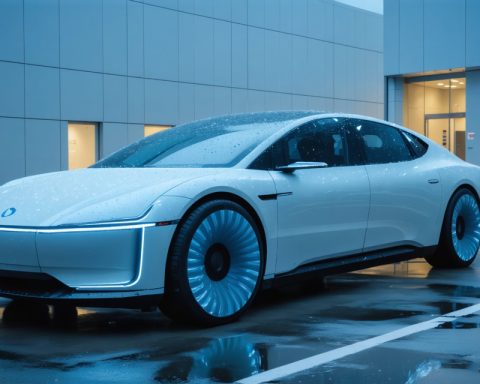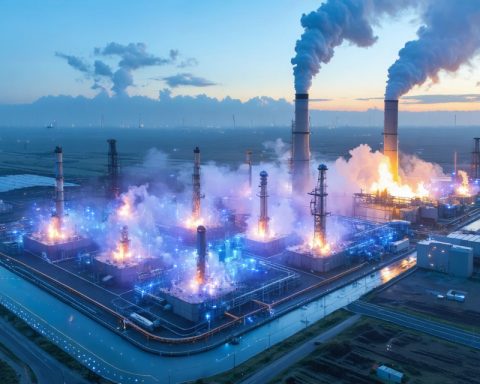- Floating wind turbines offer a transformative approach to sustainable energy, capitalizing on offshore winds while minimizing environmental and visual impacts.
- Unlike traditional turbines, they use buoyant platforms and mooring lines, allowing deployment in deeper waters without disturbing seabed habitats.
- Technological innovations enable these structures to withstand harsh ocean conditions, as demonstrated by Scotland’s Hywind, the first floating wind farm powering over 20,000 homes.
- Floating turbines support global emission reduction goals, offering eco-friendly power and economic benefits to coastal communities through job creation.
- Challenges include high initial costs and complex engineering requirements, necessitating global collaboration and investment for broader adoption.
- These turbines present a promising avenue toward a renewable energy future, embodying human ingenuity and sustainable innovation.
Miles off the shimmering coastlines where land meets the azure expanse, a new wave of technology harnesses the whisper of the winds. Floating wind turbines, the avant-garde of clean energy innovation, chart novel waters in transforming how we generate sustainable power. Imagine colossal structures, swirling gracefully in harmony with the ocean’s rhythm, offering a glimpse into the future of energy.
Why Floating Wind Turbines?
Traditional wind turbines anchor in shallow waters, often resulting in disrupted sea habitats and limited scalability. Floating turbines, however, unshackle these limits. They ride on buoyant platforms, stationed beyond the horizon where winds blow fiercely yet harmlessly to land ecosystems.
These floating giants not only capitalize on the powerful offshore winds but also circumvent the hindrances of seabed anchors. Assembling further from shore, they mitigate concerns about visual pollution and offer a serene vista of uninterrupted seascapes.
The Mechanics Behind the Magic
Engineers design these leviathans with intricate precision. Platforms resemble massive pontoons, securely tethered to the ocean floor with mooring lines. Turbines, towering like titans at sea, reach up to 800 feet high. The components must withstand relentless oceanic forces while ensuring stability—a feat of modern engineering prowess.
Scotland, a vanguard in this domain, recently unveiled the world’s first floating wind farm, Hywind. The project powers over 20,000 homes, a testament to the immense potential locked within these new-age harnessers of energy.
Environmental and Economic Benefits
Beyond generating green power, floating turbines lessen reliance on fossil fuels, thereby advancing global emission targets. Construction processes reduce environmental footprints compared to their stationary counterparts, utilizing less intrusive methods to settle these platforms into place.
Economically, the appeal is unmistakable. Coastal communities stand to gain from job opportunities in manufacturing, assembly, and maintenance—a boon to local economies that promotes sustainable growth.
Challenges on the Horizon
Nevertheless, the journey is far from smooth sailing. High initial costs and technical complexities pose hurdles. The visible migration of floating wind projects to the forefront signals a resolve to overcome these barriers, but widespread adoption requires concerted global efforts and investment.
A Blueprints for Tomorrow
Floating wind turbines represent a step toward a cleaner, renewable energy future, bridging the gap between today’s needs and tomorrow’s aspirations. They stand not only as symbols of technology’s promise but also of humanity’s willingness to innovate sustainably.
In the end, the vast, untapped potential of floating wind offers both inspiration and an imperative. As we set our sights on this horizon, we redefine what’s possible, sculpting a world where energy is as boundless as the wind that propels it. 🌊💨
The Future of Energy: How Floating Wind Turbines Could Transform Our World
Floating wind turbines represent a groundbreaking shift in the way we perceive renewable energy, offering numerous advantages over traditional wind farms. As interest in this cutting-edge technology grows, it’s important to delve deeper into the facts, challenges, and potential of this innovation.
How Do Floating Wind Turbines Work?
Floating wind turbines employ advanced engineering to remain buoyant on the ocean’s surface. The structures are secured with mooring lines, allowing them to withstand the dynamic and often harsh marine environment. This design helps achieve maximum energy efficiency by positioning the turbines where wind speeds are optimal and consistent. According to Ocean Energy Group, these turbines can be located in deeper waters, exploiting stronger and more reliable wind currents while minimizing visual and environmental impact.
Real-World Use Cases
A pioneer in the field, Scotland’s Hywind project, showcases the viability of floating wind technology. The floating wind farm has integrated seamlessly into the energy grid, supplying clean power to over 20,000 homes. This success story exemplifies the scalability and adaptability of the technology, potentially serving as a blueprint for worldwide implementation.
Market Forecasts & Industry Trends
The global market for floating wind turbines is set to expand rapidly. Experts predict that technological advancements and economies of scale will drive costs down, making floating wind a competitive player in the energy market. Market leaders in renewable energy, such as Ørsted and Equinor, are heavily investing in research to improve the efficiency and deployment of floating wind technology. As cited by the International Energy Agency, floating wind capacity is expected to account for 10% of global offshore wind installations by 2030.
Challenges & Limitations
Despite the promising outlook, several challenges remain. The high initial investment and complex logistics of installation and maintenance are significant barriers. Floating turbines require specialized vessels and equipment for assembly, as well as skilled labor for both setup and routine maintenance. Innovations in materials and processes are essential to overcoming these economic hurdles.
Insights & Predictions
For countries with deep coastal waters, floating wind turbines offer an opportunity to harness an abundant and underutilized energy resource. Japan, the United States, and Norway are emerging as key players interested in advancing this technology due to their geographical advantages.
Environmental and Economic Impact
Not only do floating turbines present a cleaner alternative to fossil fuels, but they also have a reduced impact on marine ecosystems compared to traditional seabed-mounted turbines. By designing systems that are less intrusive to marine habitats, these technologies promote biodiversity and sustainability.
From an economic standpoint, these projects generate jobs in the fields of manufacturing, research, and marine engineering. This growth extends beyond direct employment, as local businesses benefit from increased economic activity associated with the construction and maintenance of such infrastructure.
Actionable Recommendations
For stakeholders and policymakers looking to invest in floating wind turbine technology, consider the following steps:
1. Collaboration is Key: Partner with established leaders in offshore wind technology to leverage existing expertise and infrastructure.
2. Focus on Innovation: Invest in R&D to drive down costs and enhance efficiency. This includes materials science, engineering innovations, and new deployment strategies.
3. Community Engagement: Work closely with coastal communities to ensure that local economies benefit from employment and investment opportunities.
4. Regulatory Frameworks: Encourage the creation of supportive regulatory environments to facilitate smooth project implementation and operation.
Conclusion
Floating wind turbines are more than just feats of engineering—they represent a commitment to a sustainable and renewable future. By embracing this technology, we have the potential to drastically reduce our carbon footprint while powering the world with clean, renewable energy. As the technology matures, it will redefine our understanding of energy production, paving the way for a greener tomorrow.
For more insights on energy innovations, visit the Department of Energy and be part of the conversation on the future of sustainable power solutions.














